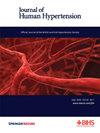老年人搏动脑、脉压、认知和降压治疗:一项功能性近红外光谱研究。
IF 3.4
4区 医学
Q2 PERIPHERAL VASCULAR DISEASE
引用次数: 0
摘要
与年龄相关的动脉僵硬增加了到达大脑微循环的脉搏,损害了脑血管健康并导致认知能力下降。高血压等心血管危险因素(cvrf)的存在会加剧这种影响。尽管对降压治疗对降低动脉僵硬的影响进行了广泛的研究,但对降压治疗对大脑微循环搏动的影响知之甚少。本研究探讨了抗高血压治疗对老年cvrf患者脑搏动和认知的影响。参与者为42名不同cvrf的老年人,分为两组:未治疗组(n = 21人,平均67.2±5.9岁,57.1%为女性)和接受降压药物治疗组(n = 21人,平均67.2±5.5岁,61.1%为女性)。处理速度和执行功能的认知得分使用Stroop测试的四个子集进行行为评估。近红外光谱(NIRS)设备记录了额叶和运动皮层亚区的血流动力学数据。这些数据随后被用来提取脑脉搏的光学指数。结果显示,在控制cvrf后,降压治疗与较低的脑脉搏率相关(未治疗组33.99±6.68 vs.治疗组28.88±5.39,p = 0.009)。两组患者的脑脉搏均与脉压相关(p本文章由计算机程序翻译,如有差异,请以英文原文为准。

The pulsatile brain, pulse pressure, cognition, and antihypertensive treatments in older adults: a functional NIRS study
Age-related arterial stiffness increases pulsatility that reaches the cerebral microcirculation, compromises cerebrovascular health and lead to cognitive decline. The presence of cardiovascular risk factors (CVRFs) such as high blood pressure can exacerbate this effect. Despite extensive research on the impact of antihypertensive treatments on reducing arterial stiffness, little is known about the impact of antihypertensive treatments on pulsatility in cerebral microcirculation. This study investigated the impact of antihypertensive treatments on cerebral pulsatility and cognition in older adults with CVRFs. Participants were 42 older adults with diverse CVRFs in two groups of untreated (n = 21, mean 67.2 ± 5.9 years old, 57.1% female) and treated with antihypertensive medications (n = 21, mean 67.2 ± 5.5 years old, 61.1% female). Cognitive scores of processing speed and executive functions were evaluated behaviorally using the four subsets of the Stroop test. A near-infrared spectroscopy (NIRS) device recorded hemodynamics data from the frontal and motor cortex subregions. The data were then used to extract an optical index of cerebral pulsatility. Results indicated that after controlling for CVRFs, the antihypertensive treatment was associated with lower cerebral pulsatility (untreated 33.99 ± 6.68 vs. treated 28.88 ± 5.39 beats/min, p = 0.009). In both groups cerebral pulsatility was associated with pulse pressure (p < 0.05). Also, treated group had significantly higher cognitive scores in executive functions compared with the untreated group (p < 0.05). These results suggest that beyond its known effect on blood pressure, antihypertensive treatments might also favor cerebrovascular health by reducing pulsatility in the cerebral microcirculation.
求助全文
通过发布文献求助,成功后即可免费获取论文全文。
去求助
来源期刊

Journal of Human Hypertension
医学-外周血管病
CiteScore
5.20
自引率
3.70%
发文量
126
审稿时长
6-12 weeks
期刊介绍:
Journal of Human Hypertension is published monthly and is of interest to health care professionals who deal with hypertension (specialists, internists, primary care physicians) and public health workers. We believe that our patients benefit from robust scientific data that are based on well conducted clinical trials. We also believe that basic sciences are the foundations on which we build our knowledge of clinical conditions and their management. Towards this end, although we are primarily a clinical based journal, we also welcome suitable basic sciences studies that promote our understanding of human hypertension.
The journal aims to perform the dual role of increasing knowledge in the field of high blood pressure as well as improving the standard of care of patients. The editors will consider for publication all suitable papers dealing directly or indirectly with clinical aspects of hypertension, including but not limited to epidemiology, pathophysiology, therapeutics and basic sciences involving human subjects or tissues. We also consider papers from all specialties such as ophthalmology, cardiology, nephrology, obstetrics and stroke medicine that deal with the various aspects of hypertension and its complications.
 求助内容:
求助内容: 应助结果提醒方式:
应助结果提醒方式:


